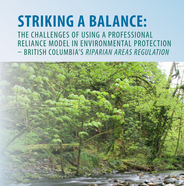The Ombudsperson’s initial 2014 report Striking a Balance examined the Ministry of Forests, Lands and Natural Operations’ (now known as the Ministry of Forests, Lands, Natural Resource Operations and Rural Development) use of what’s known as a professional reliance model in the protection of land surrounding streams, lakes and inland waters when development occurs.
Under the Riparian Areas Protection Regulation government relies on the registered members of five environmental professions (agrologists, applied biologists, applied science technologists/technicians, engineers and foresters) to conduct assessments and make recommendations to protect riparian areas from development, while government provides oversight. The Ombudsperson’s investigation found there were significant gaps in how this system operates and recommended changes to strengthen oversight, compliance with the law, public accountability and transparency.
“Clearly with the growing challenges presented by climate change, the need to have environmental professionals adhering to the highest standards is more critical than ever,” said B.C. Ombudsperson Jay Chalke. “Our initial investigation found oversight in this sector was lacking and I’m encouraged to see the province putting mechanisms in place that will give the public confidence in environmental decisions that could seriously impact the communities they live in.”
The Ombudsperson’s 2014 report made 25 recommendations, 18 of which have now been implemented including:
- All individuals who are eligible to conduct assessments under the Riparian Areas Protection Regulation must now complete a mandatory training course. The list of individuals who have successfully completed the course is publicly available (Recommendation 5);
- The ministry, in cooperation with the relevant professional associations, completed and released professional practice guidelines. These guidelines set out a standard of professional conduct for individuals who conduct assessments (Recommendation 7);
- The ministry now establishes expiry dates for assessment reports, ensuring information and recommendations in those reports reflect current site conditions (Recommendation 8);
- The ministry reviews assessment reports to ensure they are complete and in compliance with the regulation before notifying local governments, which provide the final development approval (Recommendations 10 and 12).
“While these steps demonstrate that important progress has been made, today I am calling on the ministry to continue to improve the professional reliance model in the Riparian Areas Protection Regulation,” said Chalke. Some of the key recommendations where work is still in progress include:
- Strengthening the use of site visits to track compliance and taking appropriate action where non-compliance is detected (Recommendation 13);
- Developing and implementing a process for post-development effectiveness monitoring and reporting (Recommendation 16);
- Ensuring regular public reporting on the Riparian Areas Protection Regulation (Recommendations 19,20,21)
“While this update concludes my office’s formal monitoring of government’s implementation of our 2014 recommendations, we will continue to receive and investigate complaints from the public relating to government’s protection of these sensitive ecosystems,” said Chalke.
The Striking a Balance original report and today’s update can be found on the B.C. Ombudsperson’s website.
Source: Office of the B.C. Ombudsperson, Canada

